Summary
The thermoplastic polyurethane (TPU) is used to toughen the polypropylene (PP), and the TPU/PP mass fraction ratio of 10/90 is selected to add polypropylene grafted maleic anhydride (MAH-g-PP) for compatibilization modification . The mechanical properties are characterized by tensile test and impact test, the crystallization properties are characterized by differential scanning calorimeter (DSC) and ray diffraction (AXD), and the compatibility of TPU and PP is characterized by dynamic rheological test. The results show that TPU has a significant toughening effect on PP. When the TPU mass content is 25%, the impact strength reaches 6610. 9J/m2, which is 1.66 times higher than that of pure PP. After MAH-g-PP compatibilization, the TPU/PP composite material The impact strength continues to increase, and when the mass fraction of MAH-g-PP is 0.6%, the impact strength reaches 7693.1 J/m2. The blending of TPU and PP promotes the formation of PPβ crystal form, which reduces the crystallinity and increases the crystallization temperature. The compatibilization of MAH-g-PP increases the crystallinity and crystallization temperature of TPU/PP composites. 2.4% MAH-g- The crystallization temperature, crystallinity and half-crystallization time of PP compatibilized TPU/PP(10 /90) composites reached 123.7℃, 38.9% and 0.31min, respectively, and at the same time, the β crystal form in the system disappeared.
introduction
Interfacial bonding is an important factor affecting the mechanical properties of blend-modified composites, so the compatibilization of polymer blends with different polarities is an important research field. In this paper, TPU/PP composite materials were prepared by melt blending method, and the influence of the mass fraction ratio of the two on the mechanical properties and crystallization properties of PP was studied. On this basis, polypropylene grafted maleic anhydride (MAH-g- PP) as a compatibilizer, the effect of MAH-g-PP mass fraction on TPU/PP compatibility, mechanical properties and crystallization properties was studied.
1 experiment
1. 1 Main raw materials
PP: K8003, PetroChina Dushanzi Petrochemical Company; TPU: 345X, Bayer, Germany; MAH-g-PP: grafting rate 1.2%, PO1015, ExxonMobil, USA.
1. 2 Instruments and equipment
Universal testing machine: AI-7000M, High-speed Railway Testing Instrument (Dongguan) Co., Ltd.; Impact testing machine: GT-7045-MD, High-speed Railway Testing Instrument (Dongguan) Co., Ltd.; Differential scanning calorimeter: Q-20, American TA Company ; X-ray diffraction analyzer: TD-3700, Dandong Tongda Technology Co., Ltd.; Rotational rheometer: Bohlin CVO150, Malvern, UK.
1.3 Preparation method
TPU was vacuum-dried at 80°C for 6 hours, mixed with PP and MAH-g-PP according to the formula in Table 1, under the condition of torque rheometer at 180°C and torque of 20N·m for 6 minutes, and then injection molded on a micro plunger injection molding machine .
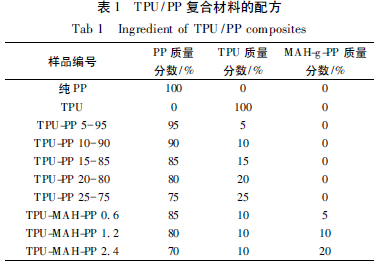
1.4 Testing and Characterization
Tensile test: The dimension and test of the tensile spline shall be carried out according to GB/T1040. 2-2006, each group shall be repeated 5 times, and the average value shall be taken.
Impact test: The size and test of impact splines shall be carried out according to GB/T1843-2008, each group shall be repeated 5 times, and the average value shall be taken.
Differential scanning measurement thermal analysis (DSC): Under the protection of high-purity N2, the temperature was raised from room temperature at 20°C/min to 200°C, kept at a constant temperature for 3 minutes to eliminate thermal history, and then lowered to 50°C at 10.0°C/min.
X-ray diffraction (XRD): Copper target, ray wavelength 1.5406nm, scan rate 0.16 (°) /s, scan range 5°~40°.
Dynamic rheological performance test: plate mode, frequency range is 0.01-100Hz, temperature is 180°C, strain is 1%.
2 Results and discussion
2.1 Mechanical properties of TPU toughened PP
Figure 1 shows the tensile/impact strength of PP, TPU and the composites prepared by blending them in five proportions. It can be seen that TPU has a significant toughening effect on PP. As the mass fraction of TPU increases from 5% to 25%, the impact strength of the composite material increases from 2857.9J/m2 to 6610.9J/m2. However, the tensile strength decreases with the increase of TPU mass fraction. On the one hand, it is because the tensile strength of TPU itself is poor. On the other hand, due to the large difference in polarity and poor compatibility between the two, the higher the TPU mass fraction, Then more phase boundaries are formed, resulting in a decrease in tensile strength.
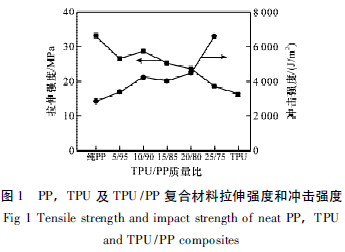
2.2 Crystallization properties of TPU/PP composites

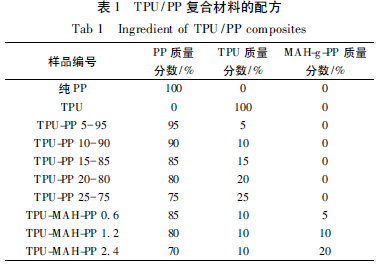
Figure 2 and Table 2 are the DSC cooling crystallization curves and related parameters of PP, TPU, and TPU/PP composite materials, respectively. The crystallization temperature of pure PP is 115.8°C, and the addition of TPU with a mass fraction of 5% to 25% can increase the crystallization temperature by about 3°C. However, the crystallinity of the composite material is lower than that of pure PP, and the crystallinity decreases more significantly with the increase of TPU mass fraction. When the TPU/PP mass ratio is 25/75, the crystallinity of PP decreases from 40.4% to 34.8%. According to the analysis, due to the polarity and asymmetry of its molecular chain, the crystallization performance of TPU is poor, the crystallization temperature and crystallinity are very low, and the melting temperature of PP is high. After blending with PP, on the one hand, it can It plays the role of heterogeneous nucleation and increases the crystal nucleus production rate of PP. On the other hand, it limits the movement of PP chain segments, resulting in a decrease in the crystal growth rate. For the improvement of PP crystallization performance, these are two contradictory effects, so it is manifested as the increase of crystallization temperature and the decrease of crystallinity.
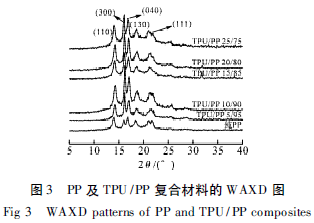
WAXD was used to characterize the crystal forms of pure PP and TPU/PP composites. It can be seen from Figure 3 that pure PP and TPU/PP composites are at 2θ=14.04°, 16.84°, 18.52° and 21.72° The (110) crystal plane, (040) crystal plane, (130) crystal plane and (111) crystal plane appeared in the PPα crystal form, and the (300) crystal plane in the PPβ crystal form appeared at 2θ=16.04°. The peak positions of the composite materials of each component are consistent with those of pure PP, indicating that the addition of TPU has no effect on the crystal form of PP. With the increase of TPU mass fraction, the intensity of diffraction peaks showed a trend of first increasing and then decreasing, especially the diffraction peak at 2θ=16.04° reached the maximum value when the TPU/PP mass ratio was 10/90, indicating that the addition of TPU is beneficial to PP Further formation of the β crystal form. In the crystal form of polypropylene, the β crystal form is a metastable crystal structure. It is believed that the addition of TPU hinders the orderly arrangement of PP chain segments during the crystallization process, resulting in an unstable crystal structure with higher energy. Due to the poor compatibility between TPU and PP, as the mass fraction of TPU continues to increase, TPU and PP form two incompatible phase regions, and the influence on the crystal form of PP is reduced. The β-crystalline polypropylene is considered to have the characteristics of low modulus and good toughness, which also confirms the change law of the mechanical properties of the composite material with the mass fraction ratio of TPU/PP.
2.3 Rheological properties and compatibility of MAH-g-PP compatibilized TPU/PP composites
After a comprehensive comparison of the mechanical properties and crystallization properties of TPU toughened PP, a formula with a mass ratio of TPU/PP of 10/90 was selected. On this basis, the PP grafted MAH compatibilizer (MAH-g-PP) was added to The MAH-g-PP group is introduced into the system to increase the compatibility of PP and TPU. The composites were first characterized by dynamic rheological frequency sweeps (180°C). It can be seen from Figure 4a that with the increase of the mass fraction of MAH-g-PP in the system, the elastic modulus of the material gradually decreases, because MAH-g-PP improves the compatibility of PP and TPU, and the two form More phase interfaces are formed, and the entry of TPU increases the molecular chain spacing in the PP phase region, and reduces the intermolecular force, which is manifested as a decrease in melt strength. The viscous modulus has a similar change rule. Similarly, after MAH-g-PP is compatibilized, TPU acts like a plasticizer in the system, and the complex viscosity of the composite decreases with the enhancement of compatibilization. The composite materials before and after compatibilization did not appear obvious Newtonian plateau, and the complex viscosity of the melt showed a large dependence on frequency.
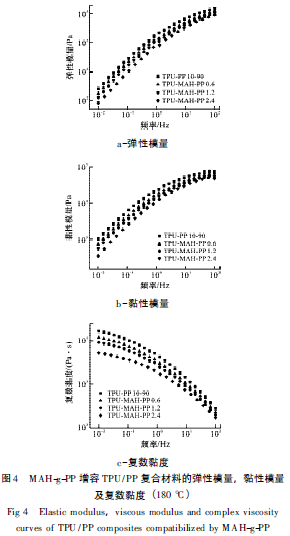
The Cole-Cole curve is a plot of the imaginary part (η″) of the complex viscosity against the real part (η’), which is often used to reflect the compatibility of the blend system. TPU/PP composites with different MAH-g-PP mass fractions are in The Cole-Cole curve at 180 °C is shown in Figure 5. The Cole-Cole curve of the composite without compatibilization deviates most seriously from the semicircle arc. With the increase of the mass fraction of MAH-g-PP, TPU plays a role in the system. The effect of the plasticizer, the modulus is getting smaller and smaller, the degree of Cole-Cole curve deviation from the semicircle gradually decreases, when the mass fraction of MAH-g-PP increases to 2.4%, the Cole-Cole curve presents a In a typical semi-circular arc, the two phases of TPU and PP have achieved complete mutual compatibility.
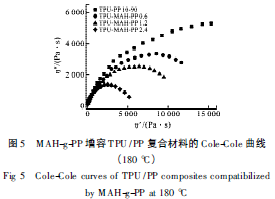
2.4 Mechanical properties of MAH-g-PP/TPU/PP composites
Figure 6 shows the tensile strength and impact strength of the composite material after MAH-g-PP compatibilization. After the compatibility is improved, the phase interface increases and is evenly distributed in the system. When the material is impacted, the energy can be effectively To disperse.

2.5 Crystallization properties of MAH-g-PP/TPU/PP composites
MAH-g-PP acts as a plasticizer in the system, which improves the mutual compatibility between TPU and PP, enhances the movement ability of PP chain segments, and helps to increase the crystal growth rate during the crystallization process. It can be seen from Figure 7 and Table 3 that with the increase of the mass fraction of MAH-g-PP, the crystallization temperature is effectively increased. When the mass fraction of MAH-g-PP is 2.4%, the crystallization temperature of the composite reaches 123.7 °C , increased by 5.0°C compared to the uncompatibilized composite, and increased by 7.9°C compared to pure PP, with a similar increase in crystallinity and crystallization rate. In the system, TPU plays the role of heterogeneous nucleation due to its higher melting point, which increases the crystal nucleation rate of PP; while the addition of MAH-g-PP enhances the mobility of molecular segments, which improves the crystallization rate of PP. growth rate.
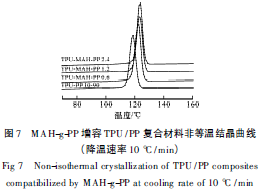
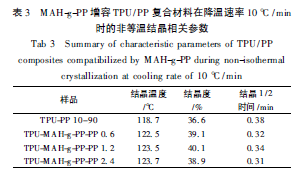

Figure 8 shows the WAXD spectra of each composite material. Corresponding to the DSC results, the addition of MAH-g-PP is beneficial to the improvement of PP crystallization properties, and the intensity of WAXD diffraction peaks increases with the increase of the mass fraction of MAH-g-PP. It is worth noting that the intensity of the diffraction peak at 2θ=16.04° was significantly weakened and disappeared during the compatibilization process of MAH-g-PP. It shows that in the process of the mutual compatibility between TPU and PP gradually increasing, the β crystal form of PP gradually disappears. Combined with the conclusion of the complex viscosity in the rheological characterization, it is believed that the movement ability of PP in the fully compatible system is strong, and it tends to form a stable The crystal structure of the state, that is, the α crystal form.
3 Conclusion
1. The blending of TPU and PP promotes the formation of β crystal form, increases the crystallization temperature but reduces the crystallinity, and can play a significant role in toughening.
2. After adding MAH-g-PP for compatibilization, the degree of mutual compatibility between TPU and PP gradually increased, and the viscosity decreased. When the mass fraction of MAH-g-PP was 2.4%, it reached complete mutual compatibility.
3. Fully compatible TPU / PP composite material, the PP molecular chain movement ability is enhanced, the crystallinity and crystallization temperature are improved, and the β crystal form gradually disappears.











